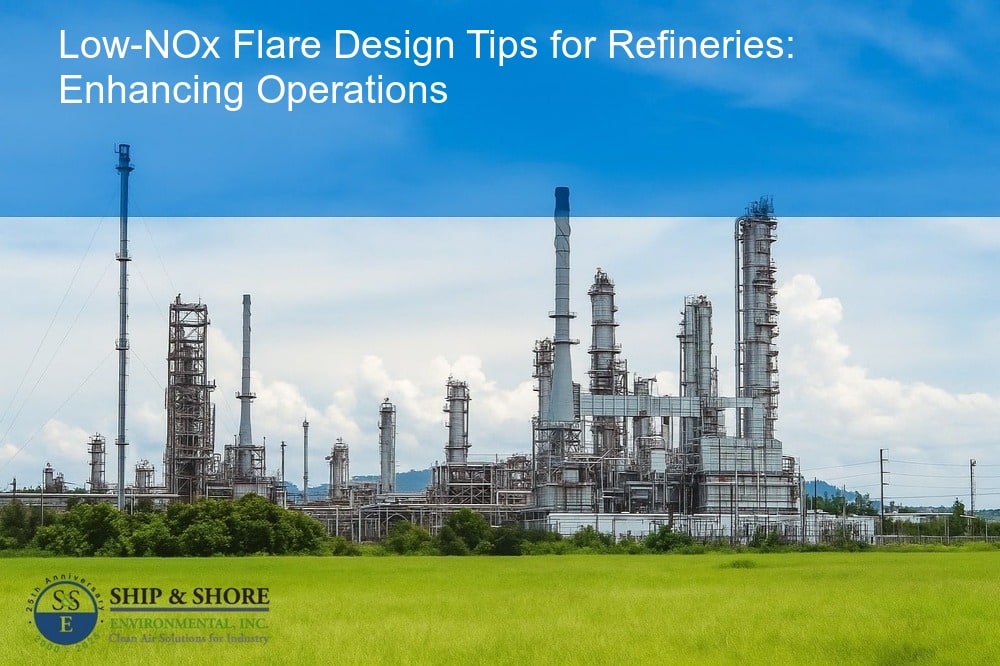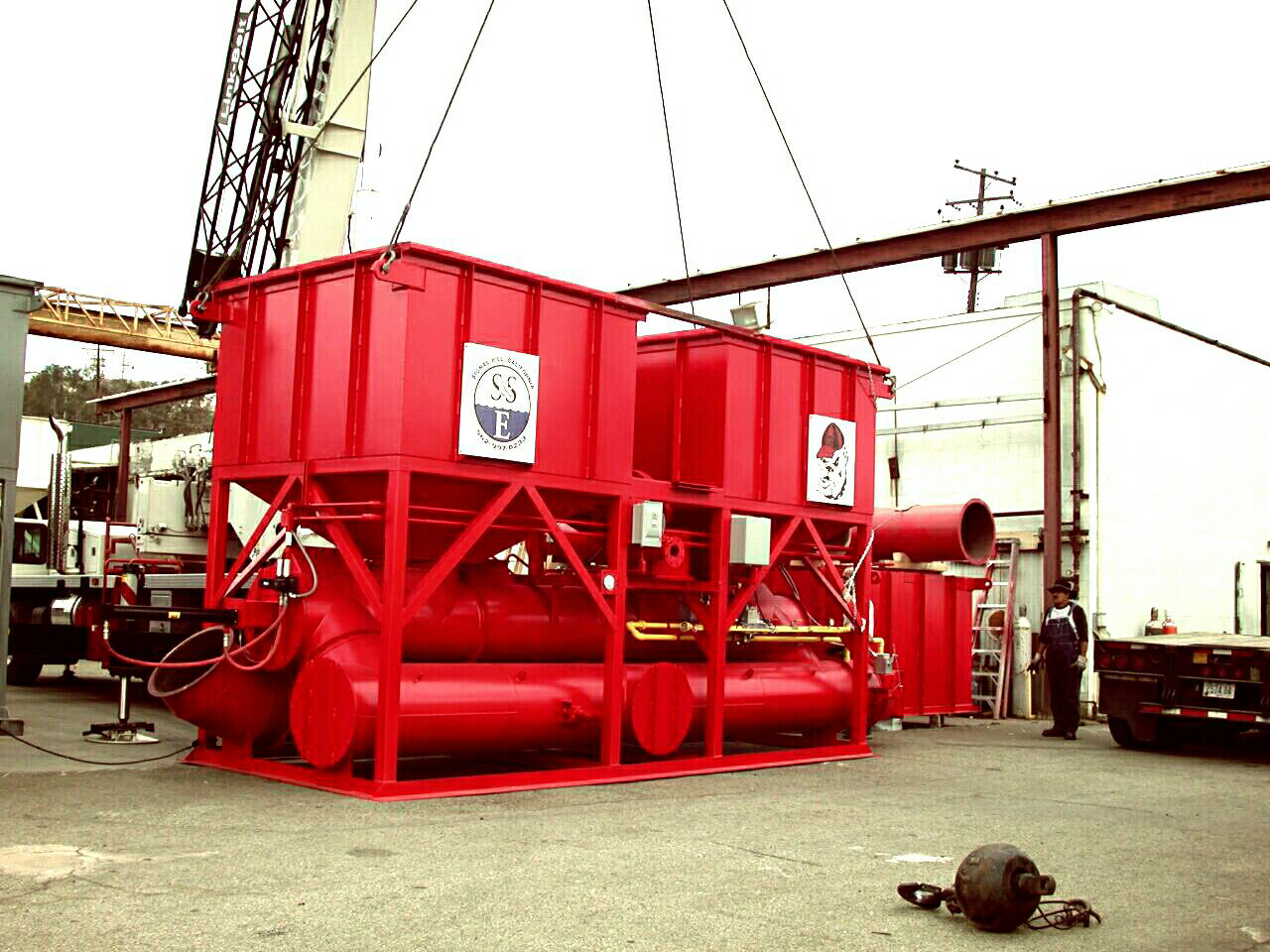
Navigating Low-NOx Flare Design Tips for Refineries: A Guide
August 22, 2025 1:18 amIntroduction to Low-NOx Flare Design: Understanding the Basics
At Ship & Shore Environmental, Inc., we understand the critical importance of incorporating Low-NOx flare design tips for refineries. As regulatory standards become increasingly stringent, the need for efficient and environmentally-friendly flaring solutions has never been more pressing. This section delves into the fundamentals of Low-NOx flare design, elucidating the core elements and considerations that must be addressed to align with both compliance and operational efficiency.
The Importance of Low-NOx Flares in Refineries: Why it Matters?
Low-NOx flares are crucial in minimizing the environmental impact of refinery operations. These specialized flares are designed to significantly reduce nitrogen oxide (NOx) emissions, which are a primary contributor to air pollution and smog formation. By adopting Low-NOx flares, refineries can not only align with stringent environmental regulations but also contribute to improved air quality and public health.
Moreover, Low-NOx flares promote sustainable operations. They support refineries in achieving long-term environmental goals while also enhancing their reputation as industry leaders in eco-friendly practices. Ensuring that flaring processes are compliant with environmental regulations also helps in avoiding potential fines and sanctions, thereby adding a layer of financial security to operational activities.
Key Challenges in Low-NOx Flare Design for Refineries
While the benefits of Low-NOx flare design are undeniable, implementing these systems in refineries presents its own set of challenges. One of the primary obstacles is the technical complexity involved in integrating Low-NOx technology with existing refinery infrastructure. Retrofitting current systems to accommodate new flare designs requires meticulous planning, comprehensive engineering assessments, and significant financial investment.
Another key challenge is ensuring that the Low-NOx flares operate efficiently under varying conditions. Refineries often deal with fluctuating flow rates and compositions of waste gases, which can affect the performance of Low-NOx flares. Designing a flare system that can maintain low NOx emissions under these variable conditions demands advanced engineering solutions and precise control mechanisms.
Balancing the economic and environmental aspects also poses a challenge. While the initial costs for Low-NOx flare systems can be substantial, the long-term benefits in terms of regulatory compliance, reduced emissions, and potential cost savings on emission penalties make this investment worthwhile. However, justifying this expenditure to stakeholders requires a clear articulation of both immediate and future benefits.
Key Considerations in Low-NOx Flare Design: Crucial Elements to Keep in Mind
In the growing quest for sustainability, understanding the key considerations in low-NOx flare design becomes pivotal for refineries. One crucial element is the flame stability, as it directly impacts the NOx emissions. Consistent flame stability ensures minimal fluctuation in combustion, thus lowering NOx levels. Additionally, residence time, the duration wherein the gases remain in the combustion zone, plays a vital role. An optimized residence time facilitates complete combustion, significantly reducing NOx emissions.
Moreover, it is essential to consider the blend of combustion air and fuel. Controlling the stoichiometric ratio – or the ideal air-fuel mixture – is crucial for maintaining efficient combustion. Excess air can cause dilution, while insufficient air can lead to incomplete combustion, both scenarios leading to higher NOx emissions. Therefore, precise control mechanisms need to be integrated into the flare design.
Turning Challenges Into Opportunities: Innovative Low-NOx Flare Design Tips for Refineries
While designing low-NOx flares for refineries, it is often beneficial to turn challenges into opportunities. One effective low-NOx flare design tip for refineries is leveraging advanced technologies like computational fluid dynamics (CFD). By using CFD, we can simulate different flare configurations and predict NOx emissions under various conditions. This helps in identifying the most effective designs and optimizing them for low emissions.
Another innovative solution lies in adapting hybrid combustion systems. Combining traditional combustion with staged combustion techniques can significantly reduce NOx levels. For instance, utilizing two-stage combustion allows for burning the fuel in low-oxygen conditions in the first stage, limiting NOx formation. The second stage involves complete combustion with sufficient oxygen, ensuring efficient fuel utilization and lower overall emissions.
Further, integrating automatic control systems can also make a big difference. Automated systems can continuously monitor combustion parameters and adjust the air-fuel ratio in real-time, optimizing the process for minimal NOx emissions. These systems not only enhance operational efficiency but also ensure compliance with stringent regulatory standards.
Case Studies: Examples of Effective Low-NOx Flare Design in Refineries
Real-world examples can provide valuable insights into effective low-NOx flare design. In one notable case, a refinery adopted a multi-point injection system to achieve low NOx emissions. By injecting the fuel at multiple points along the flare, they managed to maintain uniform combustion and significantly reduce NOx levels. This approach also improved flame stability and overall flare performance.
Another case study involved the implementation of advanced burner designs featuring air staging. The refinery incorporated burners that allowed for air to be introduced in stages, creating regions of fuel-rich and fuel-lean conditions. The staged air intake resulted in more efficient combustion and less NOx formation.
Lastly, a refinery utilized high-efficiency scrubbers to treat flue gases and absorb NOx emissions post-combustion. This technology effectively reduced the overall NOx emissions and demonstrated a successful application of end-of-pipe solutions in conjunction with advanced flare design. The integration of scrubbers highlighted the importance of complementing flare design with additional emission control technologies for optimum results.
- Leverage advanced technologies like computational fluid dynamics (CFD).
- Implement hybrid combustion systems for reduced NOx levels.
- Integrate automatic control systems for real-time optimization.
- Adopt multi-point injection systems for uniform combustion.
- Utilize advanced burner designs with air staging.
- Incorporate high-efficiency scrubbers for post-combustion treatment.
Did you know low-NOx flare designs significantly reduce nitrogen oxide emissions in refineries, thus playing a crucial role in environmentally responsible industrial operations?
Future Directions: Next Generation Low-NOx Flare Design for Refineries
As we look towards the future, the next generation of Low-NOx flare design is poised to play a crucial role in the transformation of refineries. Emerging technologies are constantly pushing boundaries, creating innovative solutions to meet stringent environmental regulations and operational challenges. These advancements are expected to not only reduce NOx emissions more effectively but also improve overall efficiency and reliability. By integrating state-of-the-art monitoring systems and adaptive control technologies, refineries can optimize performance and ensure compliance while minimizing environmental impact. The adoption of cutting-edge materials and engineering practices will further enhance the durability and effectiveness of flares.
Round-Up: Summarizing Key Low-NOx Flare Design Tips for Refineries
To encapsulate our journey through the intricacies of Low-NOx flare design, it’s clear that several factors are critical for success. First and foremost, understanding the fundamental principles of combustion and emissions control is paramount. This enables us to select the appropriate flare technology and customize it based on specific refinery requirements. Additionally, implementing advanced monitoring and control systems ensures optimal performance and compliance with environmental standards. Collaboration with experts and ongoing research contribute significantly to the continuous improvement of flare designs. These collective efforts not only help refineries meet regulatory demands but also drive sustainability and operational efficiency.
The Role of Low-NOx Flare Design in Enhancing Refinery Operations and Sustainability
The importance of effective Low-NOx flare design in refining operations cannot be overstated. By leveraging our expertise and innovative solutions, we can significantly reduce harmful emissions, safeguard the environment, and enhance overall operational efficiency. This holistic approach not only addresses current regulatory requirements but also prepares refineries for future challenges. The adoption of best practices and cutting-edge technologies drives continuous improvement and fosters a culture of sustainability. As we move forward, staying informed about the latest trends and developments in Low-NOx flare design tips for refineries will ensure we remain at the forefront of environmental stewardship and operational excellence.
For more information on our advanced Low-NOx flares, please visit our products page.
FAQ
What are the key elements to consider in Low-NOx flare design for refinaries?
When designing Low-NOx flares for refineries, it is crucial to consider factors such as the type of fuel being combusted, the combustion air supply system, and the desired emission levels. We also focus on the incorporation of advanced monitoring and control systems to regulate the combustion process and ensure consistent performance. Furthermore, selecting durable materials capable of withstanding high temperatures and corrosive environments is vital for sustainability and long-term reliability.
How do refineries benefit from implementing Low-NOx flare solutions?
By implementing advanced Low-NOx flare solutions, refineries benefit in multiple ways. Firstly, they achieve compliance with stringent emission regulations, helping to safeguard the environment. Secondly, the efficiency of operations is enhanced due to optimized combustion processes. Additionally, embracing these eco-friendly technologies demonstrates a commitment to sustainability and can bolster the refinery’s reputation in the industry. As a result, refineries can anticipate not only immediate compliance advantages but also long-term operational improvements.
Can you provide examples of successful Low-NOx flare implementation in refineries?
Absolutely, we have numerous case studies showcasing the effective implementation of our Low-NOx flare systems. For instance, a refinery in Texas was able to reduce its NOx emissions by 45% after upgrading to our customized flare design. Our project in California witnessed a 50% drop in NOx levels, alongside enhanced combustion efficiency. These examples illustrate how refining operations can achieve substantial emissions reductions and operational benefits with the proper design and technology.
What future technologies are anticipated for the next generation of Low-NOx flares?
The next generation of Low-NOx flare technologies is anticipated to incorporate even more sophisticated monitoring and adaptive control systems, allowing for real-time adjustments to optimize combustion and minimize emissions. Additionally, new materials that are both more resilient and efficient are likely to be employed, increasing the longevity and efficacy of the flares. We are also exploring the potential integration of renewable energy sources to power auxiliary systems, thus reducing the carbon footprint of our flare solutions.
How does Low-NOx flare design contribute to refinery sustainability?
Low-NOx flare design is a critical component in advancing the sustainability goals of refineries. By minimizing nitrogen oxides emissions, these flares not only reduce environmental pollution but also help to conserve natural resources through more efficient fuel combustion. Our commitment to constantly improving flare design technology enables refinaries to meet and surpass environmental regulations, thus contributing to a cleaner, more sustainable future for the industry and communities alike.
Categorised in: Blog

